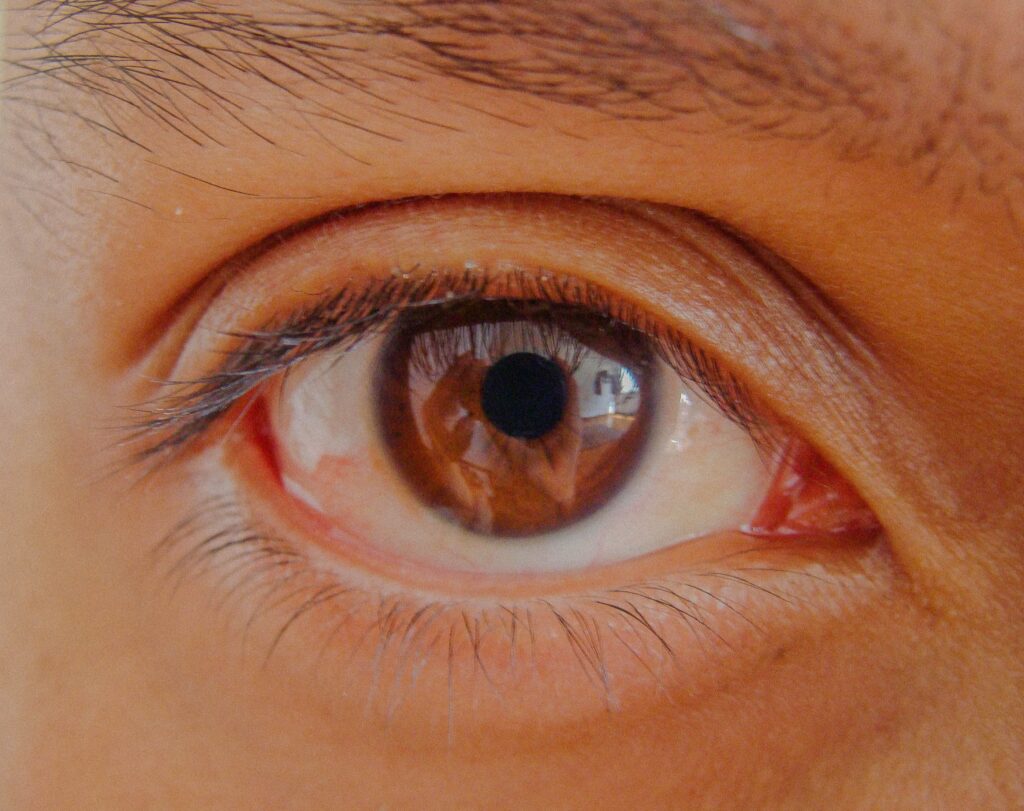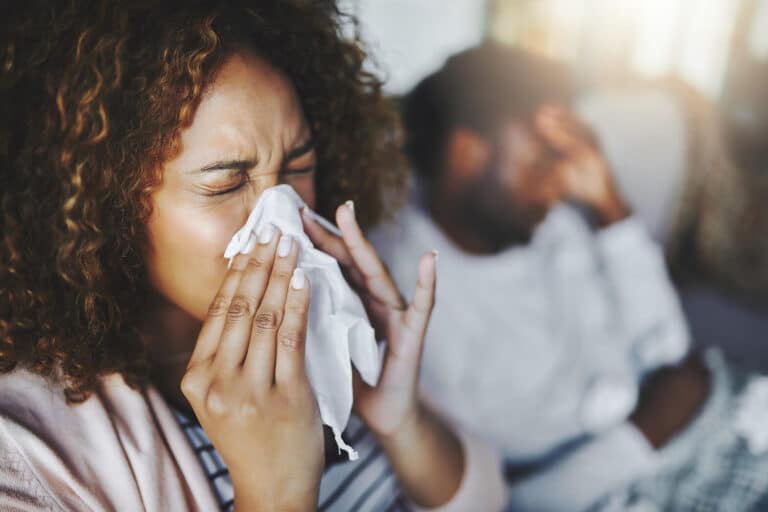There’s nothing more irritating than eye irritation. . . and when it doesn’t involve rose-colored lenses, having pink eye isn’t fun.
Pink eye is the inflammation of the transparent membrane lining the eyelid and eyeball – this membrane is called the conjunctiva. Therefore, pink eye is also known as conjunctivitis. And when small blood vessels in the conjunctiva get irritated and swollen, they’re more visible and often appear reddish or pink.
From typical pink eye symptoms (you should keep an eye out for), to whether it’s just allergies, and everything in between, here’s everything you need to know about understanding pink eye symptoms in adults.
Understanding Pink Eye Symptoms in Adults
Pink eye could be caused by a viral or bacterial infection or even an allergic reaction. Although, it’s most often caused by a viral infection. Both viral and bacterial pink eye are highly contagious, and anyone with pink eye should stay home until their symptoms clear.
Pink eye typically causes painful, red, and itchy eyes.
Here are the most common pink eye symptoms in adults:
- Redness in one or both eyes.
- Itchiness in one or both eyes.
- A feeling of grittiness in one or both eyes.
- A discharge in one or both eyes (which forms a crust during the night and may make it difficult to open your eye/s in the morning).
- Tearing or oozing.
- Sensitivity to light (photophobia).
Since pink eye can be contagious, getting diagnosed early and taking certain precautions helps limit the spread. And while it can be irritating, it rarely affects a person’s vision. You can get treatments to help ease the discomfort (more on that below).
Types of Pink Eye
The three main types of pink eye are:
- Allergic
- Viral
- Bacterial
Let’s go over the main causes of each.
Allergic Pink Eye:
When pink eye is brought on by allergies, it’s not contagious. Potential causes of allergic pink eye include typical allergy triggers such as:
- Grass, tree pollen, etc
- Animal dander
- Dust
- Mould
- Ragweed
Viral Pink Eye:
People can contract viral pink eye – pink eye caused by a virus – from an infection spreading from the nose to the eyes. It can also be transmitted through droplets from a cough or sneeze getting into the eye. Pink eye caused by a virus may be caused by an upper respiratory infection or even the common cold.
Viruses responsible for pink eye include:
- Adenovirus (the most common).
- Herpes virus (uncommon but more dangerous).
Bacterial Pink Eye:
Common causes of bacterial pink eye spreading from person to person include:
- Sharing personal hygiene or other items.
- Using unclean or old makeup products or brushes that collected bacteria.
- Touching eye/s with dirty hands.
Bacterial pink eye infections could last up to 10 days without treatment. But when treated, these pink eye cases resolve within a few days. If it doesn’t go away with antibiotic drops, it’s likely to be viral instead of bacterial pink eye.
How Long Do Pink Eye Symptoms Last?
How long pink eye lasts depends on what type of pink eye you have.
- Pink eye caused by bacteria: usually takes about 24-48 hours before symptoms start clearing up (with antibiotics).
- Pink eye caused by a virus: takes anywhere from a few days to two weeks to clear up, depending on the severity of the infection.
- Pink eye caused by an allergy: normally clears up as the other allergy symptoms lessen.
As long as pink eye symptoms are still present, a person is considered contagious. This is true in all cases of pink eye, except when it’s caused by allergies (which is most common).
So, when it comes to pink eye symptoms in adults, how can you tell if you’re still contagious?
Here are seven signs:
- Discharge from the eyes
- Crusty eyelashes and lids
- Swelling around the eyes
- Burning sensation
- Eyes tearing up and watering
- Red or pink in the whites of the eyes
- Irritation of the eyes

Pink Eye Symptoms vs Allergies
Pink eye symptoms in adults and allergies appear similar – despite having different causes. Both come with redness in your eye/s and tearing, and both are types of conjunctivitis.
So, what’s the difference between pink eye and allergies? Well, it all boils down to the cause of the inflammation. Allergies are triggered by different irritants (like pollen or animals), while pink eye not caused by allergies is an infection caused by a virus or bacteria.
How to Get Rid of Pink Eye
Naturally, the type of pink eye treatment depends on the type and severity of the infection.
Mild cases of both viral and bacterial pink eye may clear up on their own within a few days, even without medical attention. While allergic pink eye usually clears as soon as the allergic reaction is under control.
As the condition heals, the following can be used to ease discomfort:
It’s also advisable to do the following:
In more severe cases a doctor may prescribe the following medication:
- Antibiotic eye drops to clear bacterial infections.
- Antiviral medication to fight a viral infection (like herpes).
When to See a Doctor
Eye redness could be a symptom of serious eye conditions. These conditions may cause eye pain, feeling like something is stuck in your eye, blurred vision, and light sensitivity. If you are experiencing these symptoms, you should seek urgent care.
People who wear contact lenses should stop wearing their contacts as soon as pink eye symptoms begin. If your symptoms don’t start to get better within 12-24 hours, make an appointment with your eye doctor to make sure you don’t have a more serious eye infection related to contact lens use.
Make an appointment with a doctor (from anywhere) using the Air Doctor app now.












